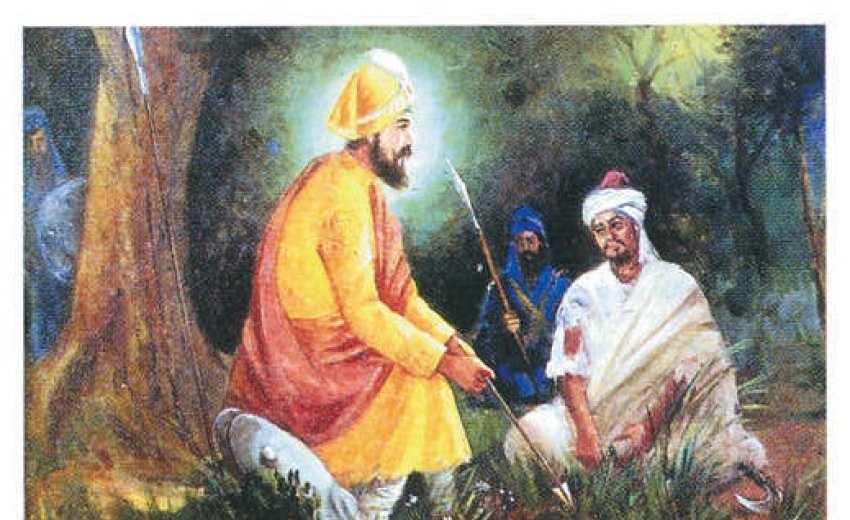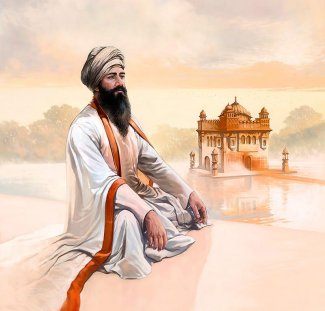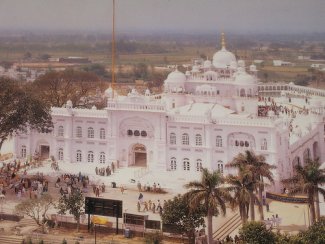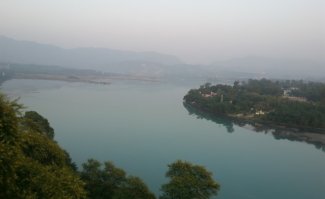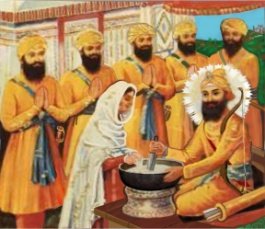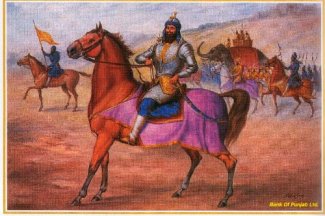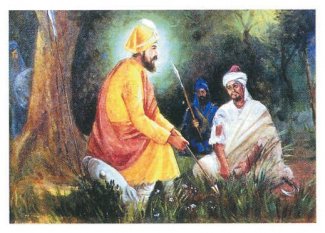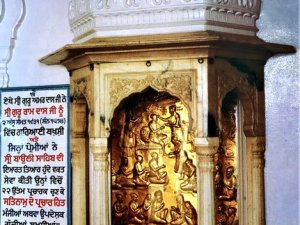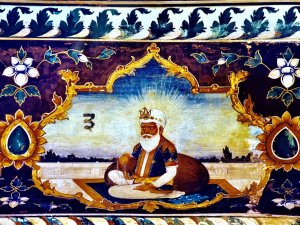“The relationship between you and history is this: When you study history, you think you’re studying a record of events in the past. And that’s not right. What you’re studying is the circumstances that gave rise to you as a being. And unless you understand your history in every way you possibly can, then you’re an incomplete creature. You don’t know enough to move forward.” ~ Jordan Peterson
The above quote by the Canadian psychologist Jordan Peterson sums the depth of who the humans are. But we the Sikhs have further handicapped ourselves, by failing to write our own history, whatever others have written we dismissed it biased, instead of freeing from it. This would have produced an unbiased history making it truer, authentic, and balanced. However, the path that we have embarked upon is to forget the history altogether, blaming the writers for the shortcomings, without taking the validation route. One such piece of history is life of Guru Gobind Singh Ji. A short life span of 42 years which can be summed as full of challenges, revolutionary changes, fights for survival, inspiring, uplifting the downtrodden.
Gobind Rai was born to father Guru Tegh Bahadur and Mother Mata Gujri on December 22, 1666, in Patna, Bihar. The only child of Guru Tegh Bahadur Ji, who was 45 at that time, 23 years after his marriage. He was in Dacca at that time, yet he continued his travels eastwards, heading to Dhubri in Assam and other places in Assam and Bengal before returning back home to Patna. Such was Guru Ji’s commitment to his cause and mission, that even such a significant event did not cause changes to his plans. Finally, Guru Tegh Bahadur Ji first saw Gobind Rai when he was about 4 years old.
From Patna, Guru Tegh Bahadur Ji hastened towards Anandpur Sahib, because of the Emperor Aurangzeb’s policy of persecution and forceful conversions of Hindus and other non-Muslims, arriving in Delhi in August 1670. Guru Ji reached Anandpur Sahib along with child Gobind Rai in February 1671. During this journey they witnessed massive destruction of temples and heard stories of torture and killing of the innocent victims. Some writers have documented the destruction, carnage that was unleashed following Aurangzeb’s orders in 1669 that the entire towns and even provinces became depopulated from religious violence. Later in Anandpur, a Kashmiri Pandit’s delegation of 500 led by Kirpa Ram of Mattan visited Guru Ji in 1675 to share their tragic plight of persecution and forced conversion. During that historical meeting the child Gobind Rai had walked into the somber atmosphere of the meeting room, seated himself in his father’s lap and enquired about the visitor’s purpose. After hearing from Guru Ji, he suggested that there was none more qualified than him to offer his life for the Kashmiris right to practice their faith. The implication of such a response challenging the royal decrees was very clear to Guru Tegh Bahadur Ji and child Gobind Rai. Guru Ji was executed on November 11, 1675, at the Kotvali opposite of Red Fort, in Delhi for refusing his conversion, thus protected Hindu faith. Guru Tegh Bahadur had anointed his child Gobind Rai of 9, as the next Guru before departing from Anandpur. Thus, young Gobind Rai had lost his father at very young age of 9. The supreme sacrifice by Guru Ji is revered as shield of India “Hind de chaddar.”
Although Guru Gobind Rai had spent very little time with his own father, still the weight of his mission in life was clear to him. He did not get to stay in Anandpur for long, but had to move to Paunta Sahib in April 1685, at the invitation of Raja Medini Parkash of Nahan. It was his strategic move to lie low and not give Hill-Chiefs an excuse to mount an attack on Anandpur on a fabricated pretext. He used his time there in creative writings by writing Jaap Sahib, Tav Prasad Saweeyae, and Akal Ustat.
Then on 15 April 1687 (16 April 1689 to Prof. Kartar Singh & Bhai Kahan Singh Nabha, 18 September 1688 according to Surjit Singh Gandhi) Guru Gobind Rai, 21 years old was forced to fight against the combined forces of valiant King Fateh Shah, his ally Hari Chand of Hadur. The volunteer rag-tag army was facing a professional army, whose mandate was to wipe out Guru Ji. Guru Ji made a strategic move of selecting the heights of a hillock Bhagani for visibility to check on the approaching armies. The Guru’s Sikhs fought valiantly with courage and determination. Guru Ji’s arrow killed Hari Chand and aggressors beat a hasty retreat along with Fateh Shah. This victory was a major morale booster for the Sikhs. Guru Ji’s composition “Bichitar Natak” gives the glimpses of the key details of this battle. Guru Ji credits his Sikhs for this victory, while expressing his own humility in these words:
ਇਨਹੀ ਕੇ ਪ੍ਰਸਾਦਿ ਸੁ ਬਿਦਯਾ ਲਈ ਇਨਹੀ ਕੀ ਕ੍ਰਿਪਾ ਸਭ ਸੱਤ੍ਰ ਮਰੇ ॥ ਇਨਹੀ ਕੀ ਕ੍ਰਿਪਾ ਕੇ ਸਜੇ ਹਮ ਹੈਂ ਨਹੀਂ ਮੋ ਸੋ ਗਰੀਬ ਕਰੋਰ ਪਰੇ ॥ ੨ ॥
“Einehee Kae Prasadh Si Bidhaya Laee Einehee Kee Kripa Sabh Sathr Marae. Einehee Kee Kripa Kae Sajae Hum Hain Neheen Mo So Gareeb Karor Parae. 2.” (Gyan Probodh)
Translation: It is through their grace that I have gotten (arms) education, and through their assistance I have conquered all my enemies. It is through their assistance that I have attained this status, otherwise there are millions of unknown mortals like me.
Guru Ji despite victory did not occupy the territory of defeated Hill-Chiefs, instead decided to return to Anandpur after taking care of the wounded and disposal of the dead bodies. The Rani of Bilaspur came forward requesting Guru Ji to stay as her state guest, which he agreed to. Guru Ji returned back to Anandpur after a lapse of four years. There he started the tradition of celebration of Hola Mohalla instead of Holi. The Hola Mohalla celebrations became a weeklong event, where besides display of mastery over weapons, mock war games were played to instill fighting skills and bravery in the Sikhs. Over time the significance of these celebrations waned and now the celebrations last three days.
The peace did not last a year as the Raja Bhim Chand of Nadaun was accosted by Commander Alif Khan on behalf of Dilawar Khan to pay due tributes or be ready to fight. Bhim Chand sought advice of Guru Ji then refused to pay the unreasonable demand. The inevitable battle of Nadaun took place in 1690, where the joint forces of Guru Ji and Raja repulsed the attack. Dilawar Khan next assigned Hussain Khan to extract the revenge for the rout of his forces. This time Raja Ajmer Chand, who succeeded Raja Bhim Chand agreed to pay the demanded tribute, and even joined him in a joint expedition against Guru Ji for tributes.
This resulted in another battle in Guler in 1696, which was again won by Guru Ji. Despite his preoccupations with the battles, Guru Ji still made use of peace time to write spiritual poetry. He completed Chaupai Sahib at Bibhaur, 18 KM away from Anandpur on September 14, 1696, while staying there as guest of Raja Rattan Rai.
On March 29, 1699, Guru Ji held a great gathering in Anandpur Sahib. The estimate by the royal spies puts the number of attendees to 80,000. At the conclusion of singing of Asa-De-Var, Guru Ji stepped to the podium with an unsheathed Kirpan in his hand and asked for a head. Bhai Daya Ram stepped forward to offer his head. Guru Ji took him to a separate tent and came back with the blood-soaked Kirpan and asked for another head. This was repeated additionally three more times. After these five offering their heads, Guru Ji had stayed in the tent for longer time. When Guru Ji came out of the tent his Kirpan was sheathed, his face radiated joy and satisfaction. He was followed by these five, who were dressed in new clothes like Guru Ji’s. Then next day being Vaisakhi, Guru Ji held the Khande-De-Pahul initiation to those five, asked them to adopt Singh as the last name, and presented them to the attendees gathered. He called them his beloved by naming them ‘Panj Pyaras’. Next what he did was unheard of in the annals of history, which was to ask those five to bless him with the Khande-De-Pahul. Guru Ji also adopted Singh as his last name instead of Rai. With one masterly stroke Guru Ji had ended caste based discrimination, as well as the gap between master and disciple. Bhai Gurdas Singh has penned these words to describe this revolutionary act as:
ਵਾਹੁ ਵਾਹੁ ਗੋਬਿੰਦ ਸਿੰਘ ਆਪੇ ਗੁਰੁ ਚੇਲਾ ॥੧॥
“Waho Waho Gobind Singh ape Guru Chela.” (Amrit Keertan, Pg. No. 281)
Translation: Hail, hail (Guru) Gobind Singh; He, Himself, is the Master and Disciple too.
The Hill-Chiefs alarmed at power and influence of Guru Ji growing decided to curtail it by sending a message to Guru Ji to either pay rent for Anandpur or vacate it, which Guru JI refused. In 1700 to force Guru Ji to leave two Hill-Chiefs ambushed Guru Ji’s hunting party expedition. Caught unawares the Sikhs fought valiantly and successfully beat the ambush. The outcome in defeat made the Hill-Chiefs feel insecure, so they started to form an alliance of Hill-Chiefs, to curtail the growing power of Guru Ji. At their conclave the Hill-Chiefs decided to enlist the aid of Imperial army through a petition to Governor of Sirhind, Wazir Khan. Governor obtained the emperor’s sanction and dispatched a contingent of 10,000 under command of Dina Beg and Painda Khan. The combined forces of the Hill-Chiefs and the Governor totaling over 20,000 approached Anandpur. Guru Ji had a force of 7,000 and a bloody battle ensued. Guru Ji’s eldest son Baba Ajit Singh also participated in his maiden battle and showed his mettle. As the battle was tilting in favor of Guru Ji, Painde Khan stepped forward and asked Guru Ji for one-to-one combat. Painde Khan shot 2 arrows at Guru Ji but missed his mark. After missing his aim, he was retreating, when Guru Ji asked him to stop as it was Guru Ji’s turn. Painde Khan’s body was fully covered with body armor except for his ears, so Guru Ji took aim at his ear with an arrow, which hit the target felling him to the ground. Then the panicked joint armies made a hasty retreat.
On May 03, 1704, the armies of Hill-Chiefs along with forces of Faujdars of Sirhind and Lahore reattacked Anandpur Sahib. There initial attack was met with a strong resistance, so they opted for a siege instead of engaging in a frontal assault to avoid casualties. The siege lasted over seven months with all incoming and outgoing supplies cut-off, putting the Sikhs in very dire straits as arms, ammunition, food, and water supplies were running extremely low. The hunger and starvation coupled with assurances of safe passage sounded appealing to some Sikhs, but Guru Ji saw it as a trap. Still the forty Sikhs pressed Guru Ji again to accept the safe passage offer. Guru Ji asked them to write a letter to him disowning their Guru if they desired to leave. So, they complied and left. The Mughal army gave them free pass in anticipation of more defections. Those remaining inside Anandgarh fort opted to endure hunger and deprivation, despite the worsening situation. With deaths and desertions only forty remained in the fort, while the number was 7000 at the starting of the siege. Then the enemy delivered a letter from Emperor Aurangzeb containing assurances of safe passage. The Sikhs held a conclave and decided it was need of the time to evacuate. They presented their viewpoint as Panj Pyare, which was reluctantly acceded to by Guru Ji. The preparation for evacuation started immediately.
The Sikhs evacuated the fort at the dead of night on 20 December 1704, while it was raining heavily and Sarsa stream was swollen with the rainwater. The heavy downpour with high winds blowing on a bitterly cold winter night made the evacuation challenging. Mata Gujri and Chotte Sahibzadaes got separated from the rest of contingent, landing in Kheri village next morning. Guru Ji had left behind Bhai Sant Singh and Bhai Sangat Singh primarily to give the impression that the fort was not evacuated. Early next morning the Mughal forces discovered that the fort had been evacuated so the search parties fanned out. They caught the fringe of the Sikhs crossing Sirsa and a fierce fighting ensued there. Guru Ji along with advance party had already crossed Sirsa. The Mughal forces chased the Sikhs, but still Guru Ji decided to have Asa De Vaar kirtan on the other side of Sarsa after crossing it. Then they went to Keeratpur and Nirmohgarh but were directed to go to Kotla Nihang. That was just a brick kiln in an open field, so Guru Ji went to Chamkaur on December 21, 1704. By nightfall the Mughal forces reached there and surrounded the entire village.
Next morning the arrows started flying towards the mud Haveli occupied by the Guru and his Sikhs. The first attempt of the royal forces to break the door open was successfully repulsed. The forces regrouped and made another attempt with additional reinforcements, which failed again. Next General Nahar Khan had ladders installed and he himself started climbing to make a surprise assault. As soon he lifted his head upwards, he became victim of Guru Ji’s arrow and fell flat on the ground. Gani Khan took over the lead started climbing the ladder, when Guru Ji dropped a mast on his head killing him. The spectacle panicked the invading forces, while third General Mehmood Ali was running for his own safety. Even the two elder sons of Guru Gobind Singh died fighting bravely in the battle displaying exemplary courage. By nightfall the fighting seized, the remaining five Sikhs pleaded with Guru Ji to evacuate. Guru Ji acceded to their call and decided to take Bhai Daya Singh, Bhai Dharam Singh, and Bhai Man Singh with him. Sangat Singh was dressed in Guru Ji’s clothes, complete with plume along with Sant Singh as his companion were to remain there giving them impression of being still occupied. The fate of these two remaining was obvious to become martyrs. Bhai Sangat Singh’s head was cutoff to be sent to Delhi as a proof that Guru Ji had been killed. It was only later did they realize that Guru Ji has escaped and that they were tricked. In the pitch darkness Guru Ji got separated from his three accompanying Sikhs landing alone in Machiwara forest. Exhausted, hungry, in wet clothes, Guru Ji finally got some sleep, but kept his unsheathed kirpan in his hand for his own protection.
The three Sikhs were reunited with Guru Ji in Machiwara where they found Guru Ji sleeping. From there with the help of Nabi Khan and Gani Khan, dressed as “Uch Da Pir” Guru Ji left for Jatpura. From there, he sent Mahi to find out about the Chotte Sahibzades and Mata Gujri Ji. It was here only he found out that these two young souls chose death by being bricked alive, refusing entreaties from the Nawab of Sirhind. When Nawab Wazir Khan got wind of Guru Ji’s efforts to raise forces, he sent forces. The Nawab’s forces came face to face with Sikhs at Khidrana (now called Muktsar) in 1705. This is where the earlier 40 deserters from Anandpur had rejoined Guru Ji and being at the rear of convoy fought with Wazir’s forces with strongest determination and faith. Their fate of being wiped out was clear, but their strong resistance provided the Guru Ji and Sikhs leading the move to gain some breathing space and time to get out of the harm’s way.
Before moving further, let us recap the fate of the Chotte Sahibzades and Mata Gujri Ji. They had spent the first night in Kamoh Masakhi’s hut. Next morning Gangu, who was earlier employed in Guru Ji’s kitchen approached them and invited them to stay with him in his village Kheri. At night while all three were sleeping, Gangu helped himself with the money and jewelry. When in the morning Mata Ji confronted him, he raised hue and cry and went straight to Kotwal in Morinda to report that their whereabouts. They were arrested from Gangu’s house and spent the night in the Kotwali. Next day they were moved to Sirhind and presented to Nawab Wazir Khan in his court. They were offered inducements of comfortable life and marriages into royal families if they embraced Islam. But the two Sahibzades were firm in their faith. They were given a night to think about the offer but when they did not relent, they were told that their price for defiance was death. They were bricked alive on 27 December 1704. This was the week where the history of a century unfolded in a week time.
Guru Ji moved to Talwandi Sabo from there he sent his epistle letter called Zafarnama to Emperor Aurangzeb. The name given to the letter by Guru Ji has moral significance of being a bold defiance, despite him and his family being subjected unjust persecution for an extended period. A new recension of the Adi Granth was prepared by Guru Ji here, which included writings of Guru Tegh Bahadur while Bhai Mani Singh acted as the scribe. This place came to be known as academic center par excellence in Sikh lore. Guru Ji spent less than a year here, renaming it as Damdama Sahib. The emperor’s response to Guru Ji’s Zafarnama was received here from the south. He had expressed a desire to have in person meeting with Guru Ji. Accepting the invitation Guru Ji embarked on the journey towards south.
From Talwandi Sabo Guru Ji moved to Sirsa, and then southwards in Rajasthan. There in Baghaur Guru Ji heard the news of Aurangzeb’s death in Aurangabad on February 20, 1707. Guru Ji decided to return back while Aurangzeb’s eldest son Bahadur Shah sought Guru Ji’s help in claiming the throne. On July 24, 1707; Guru Ji met Bahadur Shah in Agra and remained with him till November 1707. Bahadur Shah had to rush to south to quell the rebellion of his younger brother Kam Bakash. Towards the end of November 1708, they reached Nanded, Maharashtra. Bahadur Shah asked Guru Ji for help in his fight against Marathas. Guru Ji refused to help and decided to settle there while Bahadur Shah with his forces moved on.
It was here that Guru Ji met Madho Das. During his meeting with Guru Ji, he had told him that he was his ‘Banda’ (meaning slave). Guru Ji initiated him into Sikh fold by baptizing him and giving the name of Banda Singh but was lovingly called Banda Bahadur. Guru Ji narrated to him the atrocities committed by Wazir Khan. Guru Ji deputed him with five Sikhs under his command to punish Wazir Khan for all the atrocities that he had committed. In Nanded, a Pathan named Jamshed Khan came, and started attending assemblies of Guru Ji. In reality, he was spying looking around to carry out his nefarious attempt on the life of Guru Ji. He came and attended the assemblies for 3-4 days, when one evening he got an opportunity. While Guru Ji was sleeping with no one was watching over him, he attacked Guru Ji with his dagger inflicting a deep belly wound. But his own life was cut short by Guru Ji’s kirpan. Even the emperor’s medical team came to nurse the wounds of Guru Ji. After few days, the wound appeared to have closed but was not fully healed. Guru Ji informed the Sikhs attending on him that his time for departure had come. He anointed Sri Guru Granth Sahib as the next Guru for eternity and breathed his last on October 07, 1709.
We can see that in brief life span of 42 years he had faced multitude of challenges but was always optimistic, and charging forward relentlessly. From the short review of his life, we can see the qualities of – character, charisma, competence, courage, discipline, focus, generosity, humility, initiative, leadership, military strategist, passion, poetic temperament, positive attitude, problem solving, strategic planning, valor, and vision. All the odds could not shake his single-minded determination and resolute demeanor. He had lost his father, 4 sons, and old mother, endured hunger, loss, starvation, and deprivation; yet nothing could dampen his determination or enthusiasm. He is lovingly revered as “Sarbans Daani” – one who willing sacrificed his whole family. For a Sikh the only aspiration is to live to his ideals, as he is the master whose life captivates the Sikhs. Bhai Nand Lal who was Guru’s contemporary, eulogized the great legacy in his composition Tofeeso Sanah, saying:
ਹੱਕ ਹੱਕ ਆਗਾਹ ਗੁਰੁ ਗੋਬਿੰਦ ਸਿੰਘ ॥ ਸ਼ਾਹਿ ਸ਼ਾਹਨਸ਼ਾਹ ਗੁਰੁ ਗੋਬਿੰਦ ਸਿੰਘ ॥੧੦੭॥
“Huk Huk Agah Gur Gobind Singh. Shahai Shahanashah Gur Gobind Singh. 107.”
(Amrit Keertan, Pg. No. 285)
Translation: Guru Gobind Singh knows God very well, and he is emperor of the emperors.
References:
- Singh, Satbir. Saka Chamkaur (In Punjabi). SGPC, Sri Amritsar
- Singh, Prof. Jagdish, Singh, Satbir (Historical background). Nikien Jindan Vadda Saka (In Punjabi). SGPC, Sri Amritsar
- Singh, Singh, Kartar Prof. Life of Guru Gobind Singh. Lahore Book Shop, Ludhiana
- Grewal, J.S, & Bal, S. S. Guru Gobind Singh: A Biographical Study. Panjab University. Chandigarh.
- Gandhi, Surjit Singh. History of the Sikh Gurus (A Comprehensive Study). Gur Das Kapur & Sons, Delhi
- Chandan, Kirpal Singh. Jeewan Yatra tae Updesh Guru Gobind Singh (In Punjabi). Sikh Missionary College, Ludhiana.
- Amrit Keertan. Khalsa Brothers, Amritsar
- Verma Rajiv. Destruction of Hindu Temples. https://rajiv-varma.blogspot.com/
- www.SearchGurbani.com

